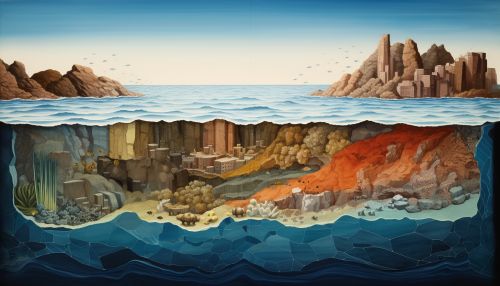Oceanic crust
Introduction
The oceanic crust is the uppermost layer of the Earth's lithosphere that is found under the ocean basins. Formed by the process of oceanic spreading, the oceanic crust is primarily composed of basalt, a type of rock that originates from upwelling mantle below the ocean ridges.


Formation
The formation of the oceanic crust is a continuous process at the mid-ocean ridges, where tectonic plates are moving apart. As the plates separate, molten rock known as magma rises from the mantle to fill the gap. This magma cools and solidifies to form new crust – a process known as seafloor spreading. The newly formed crust then moves away from the ridge and is eventually subducted beneath the continental crust.
Composition
The oceanic crust is primarily composed of basalt, which is formed from the rapid cooling of magma. This basaltic crust is subdivided into three layers: layer 1 consists of marine sediments; layer 2, of pillow basalts; and layer 3, of vertical dike complexes. The crust is also denser than the continental crust, which is primarily composed of granite.
Structure
The structure of the oceanic crust is layered, with each layer having different physical and chemical properties. The uppermost layer, Layer 1, is made up of unconsolidated sediments, while Layer 2 is composed of pillow basalts. The lowermost layer, Layer 3, is a complex of vertical dikes that feed magma from the mantle to the mid-ocean ridges.
Thickness
The thickness of the oceanic crust varies, but it is generally thinner than the continental crust. The average thickness of the oceanic crust is about 7 kilometers, compared to the 35-40 kilometers thickness of the continental crust. The thickness of the oceanic crust also changes with age, becoming thicker as it moves away from the mid-ocean ridge due to the addition of sediments and the cooling of the underlying mantle.
Age
The age of the oceanic crust is much younger than the continental crust. The oldest oceanic crust is located in the western Pacific and is estimated to be about 200 million years old. In contrast, the oldest continental crust is over 4 billion years old. The age of the oceanic crust can be determined using various dating methods, including radiometric dating and paleomagnetic studies.
Subduction
Subduction is the process by which the oceanic crust is recycled back into the mantle. This occurs at convergent boundaries, where one tectonic plate is forced under another. The subducted oceanic crust is subjected to high pressures and temperatures, causing it to melt and form magma. This magma can then rise to the surface and contribute to volcanic activity.
Significance
The study of the oceanic crust provides valuable insights into the Earth's geological history and the processes that shape its surface. It also has practical implications in the fields of seismology, natural resource exploration, and climate change studies.
See Also
- Continental crust - Plate tectonics - Seafloor spreading - Subduction zones
